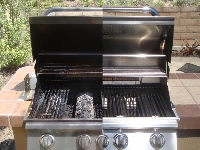
Knowing how to improve grill performnce means better burgers and brats
Summer grilling season is here and if you’re like the rest of us, you opened the gas valve, lit the burners, tossed on the burgers and brats and wondered why they’re still pink an hour later.
It takes more than a funny apron and cold beer to make a barbecue. It also takes making sure your grill’s performance is up to snuff before you sniff a whiff of grilling trouble. Good gas grill maintenance not only gets your grill ready for the season, it also can improve its performance.
Let’s take a look at some preventative measures first, then at some troubleshooting suggestions for a grill that’s not performing properly.
One easy way to up your gas grill’s performance is to keep the lid closed and the grill covered when not in use. Wet burners can eventually rust and leak, while wet rocks take longer to heat up. Another easy performance booster is to replace the lava rocks frequently. New rocks heat up faster and hold at a steady temperature longer. Replace them if they’re crumbly or smell from a coating of old drippings.
Dirty grates can also slow down your grilling. Turn the grill on high and cover it for 15 minutes, then scrape the grates with the proper scraper for your grill. Using tongs, dip a wad of paper towels in cooking oil and rub it generously over the clean grates until they shine. This is a good thing to do every time you fire up the grill because it also seasons the grate and keeps food from sticking.
~
Another way to improve the performance of your grill is to regularly clean out the gas feeds, also known as Venturi tubes. This should be done even if the gas seems to be feeding properly because small obstructions from dirt, spiders or other causes will eventually turn into bigger blockages. A good cleaning should be done immediately if the flames seem to be low even when set on high.
When the grill is cold, disconnect the Venturi tubes according to the manufacturer’s instructions – they normally just pull off or are fastened with clips. Use a pipe cleaning brush or metal skewer to clean and clear out any dirt or obstructions. Reconnect the tubes, making sure they fit tightly. While you?re behind the grill, check the gas line to the tank for any kinks and straighten them out. Connect the hose to the tank, light up the grill and check the flames.
If your grill is still heating up to slowly, the problem may be in the overflow protection device which connects to the tank. It’s a regulator required by federal law for safe use of propane. If the device has been tripped, the grill will still operate but can only heat up to 300 degrees.
To reset it, open the lid, turn off all gas knobs. close the tank valve and disconnect the regulator. Wait at least 30 seconds, then reconnect the regulator to the tank. Open the tank valve very slowly until it’s all the way open, taking care not to force it open to avoid damage. If the problem was a tripped regulator, you should now have full steady flames coming from your burners.
Still having problems? The burners may need to be replaced. Check your owner?s manual to decide if you can do this on your own or turn your grill over to a professional. Otherwise, these suggestions will both get your grill ready for barbecue season and keep it operating at peak performance for months of burger and brat bliss.

